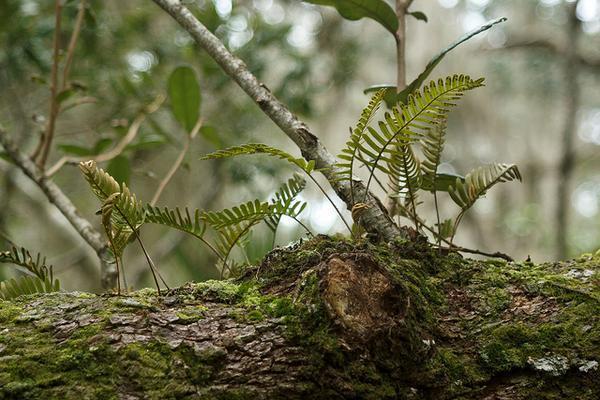Pleopeltis polypodioides
Common Name(s):
Previously known as:
- Polypodium polypodioides
- Phonetic Spelling
- plee-oh-PEL-tiss pol-ee-pod-ee-OY-deez
- Description
-
The Resurrection Fern is an evergreen fern that is typically found growing on trees (especially leaning tree trunks and Live Oak trees), fallen logs, stumps, ledges, and rocks. It will also grow on fence posts and buildings. Some of its host plants are live oak, elm, magnolia, and cypress. it is considered an epiphytic plant, which is a plant that grows on another plant and dependent on that plant for support but not nutrition. An Epiphytic plant gets moisture and nutrients from the air or from small pools of water that collect on the host plant. It is also epipetric, meaning that it can also grow on rock.
The Resurrection Fern of the SE USA is Pleopeltis michauxii, but it has long been mistakenly called P. polypodioides. The latter name is now applied only to the Resurrection Ferns of Mexico and Tropical America.
It is a difficult plant to get established. During dry periods it appears to die but regains normal appearance with rain. It spreads by creeping rhizomes. The rhizomes are covered with lance-shaped, brown scales with ciliate margins. The fronds of this plant are curled when they're dry but rehydrate quickly in the rain.
Its roots are fibrous.
VIDEO Created by NC State Extension's Homegrown series featuring Mark Weathington, Director of JC Raulston Arboretum.
- Profile Video:
- See this plant in the following landscape:
- Cultivars / Varieties:
-
- Tags:
















- Cultivars / Varieties:
-
- Tags:
-
-
Attributes:
- Genus:
- Pleopeltis
- Species:
- polypodioides
- Family:
- Polypodiaceae
- Life Cycle:
- Perennial
- Country Or Region Of Origin:
- S. Mexico to Tropical America
- Wildlife Value:
- Food Source
- Play Value:
- Wildlife Food Source
- Particularly Resistant To (Insects/Diseases/Other Problems):
- Heavy shade, Deer
- Climbing Method:
- Clinging
- Scrambler
- Dimensions:
- Height: 0 ft. 3 in. - 0 ft. 6 in.
- Width: 0 ft. 6 in. - 1 ft. 4 in.
-
-
Whole Plant Traits:
- Plant Type:
- Fern
- Herbaceous Perennial
- Woody Plant Leaf Characteristics:
- Broadleaf Evergreen
- Habit/Form:
- Clumping
- Growth Rate:
- Slow
- Maintenance:
- High
- Texture:
- Fine
-
-
Cultural Conditions:
- Light:
- Dappled Sunlight (Shade through upper canopy all day)
- Deep shade (Less than 2 hours to no direct sunlight)
- Partial Shade (Direct sunlight only part of the day, 2-6 hours)
- Soil Texture:
- Shallow Rocky
- Soil Drainage:
- Good Drainage
- Moist
- Available Space To Plant:
- Less than 12 inches
- NC Region:
- Coastal
- Mountains
- Piedmont
- USDA Plant Hardiness Zone:
- 6a, 6b, 7a, 7b, 8a, 8b, 9a, 9b, 10a, 10b
-
-
Fruit:
- Fruit Description:
- No fruits. This plants reproduces via spores.
-
-
Flowers:
- Flower Description:
- No flowers.
-
-
Leaves:
- Woody Plant Leaf Characteristics:
- Broadleaf Evergreen
- Leaf Color:
- Green
- Leaf Feel:
- Leathery
- Leaf Type:
- Compound (Pinnately , Bipinnately, Palmately)
- Fronds
- Leaf Arrangement:
- Other/more complex
- Leaf Shape:
- Lanceolate
- Leaf Margin:
- Lobed
- Hairs Present:
- No
- Leaf Width:
- 1-3 inches
- Leaf Description:
- 1 to 2 in. wide, leathery fronds with 6 to 20 alternately spaced, oblong segments joined by rounded sinuses. It has a has a blunt tip. The smaller fronds are prostrate, scaly on under surface, stipe nearly one-half length of the blade
-
-
Stem:
- Stem Color:
- Green
- Stem Is Aromatic:
- No
-
-
Landscape:
- Landscape Location:
- Container
- Small Space
- Landscape Theme:
- Fairy Garden
- Rain Garden
- Rock Garden
- Shade Garden
- Winter Garden
- Design Feature:
- Accent
- Attracts:
- Small Mammals
- Songbirds
- Resistance To Challenges:
- Deer
- Drought
- Heavy Shade
- Wind






